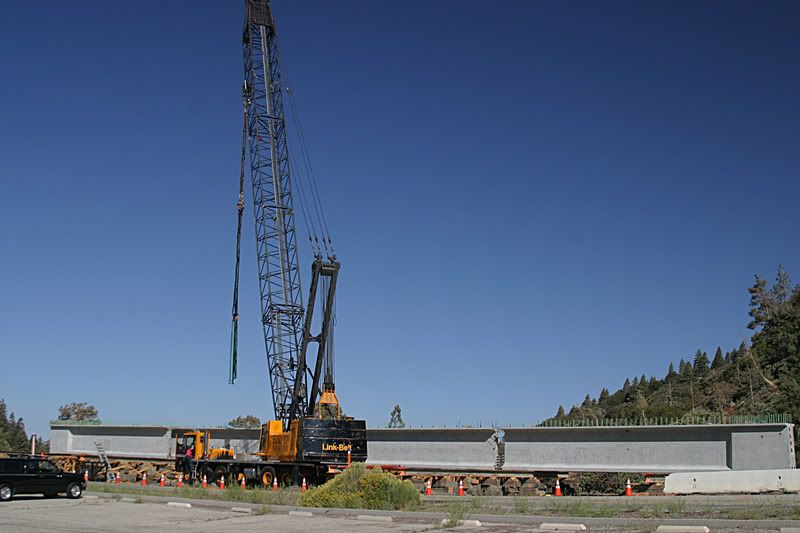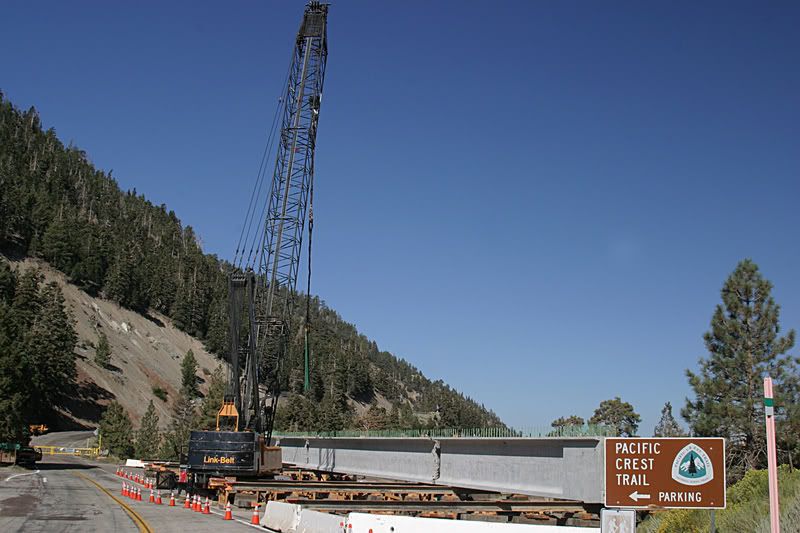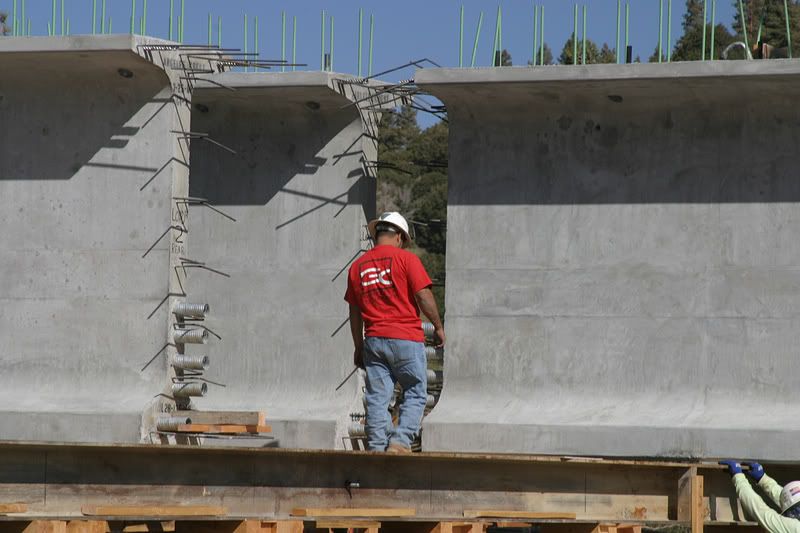By this post, three girders are in place, 2 to go (not including the new one that is still curing at the plant).
Lifting the girder onto the dollies. The green straps used by the cranes are made of Kevlar which is much stronger than cables. Each single strap can lift 100,000 lbs, many straps are used by each crane.
Setting girder onto the dollies
The two cranes stabilize the girder while it is secured to the dollies
Once the girder is secured to the dolly the 500 Ton Crane begins breaking down as it will need to follow the girder to installation site. In this picture the counter balance weights are being removed from the crane. The two smaller counter balance weights on the top each weight 5,100 lbs each. The larger counter balance weight at the bottom weights 10,000 lbs. 44,000 lbs of counter balance were used in picking up and securing the girder. MORE counter balance weight will be needed at the site for installation of the girder since its boom will need to be extended much further.
Metal frames are secured across the middle of the girder to prevent flexing during the move
The girder is chained and secured to the dolly and is now ready to move. This dolly with 8 tires in each row could support the entire weight of the entire girder itself. It can support 200 tons. The girder only weighs 170 tons. Two dollies are used in the move, one supporting the front, one supporting the back, so there is no problem with weight. The dolly is not self powered but is pulled along by a cable connected to the front dolly. The front dolly is pulled by a very large truck.
Here the dollies are being leveled. They can be raised up to 50 inches on each side.
The move begins
This 500 Ton Crane looks brand new but is two years old and cost 3 million dollars. Because of its weight and size it actually is broken down into several pieces and delivered to a site via 18 wheelers and dollies and then reassembled. We talked to the owner and he said they are constantly on the move as they are very much in demand.
The move continues at a walking pace. The first girder took an hour to get to the installation site. The second took a ½ hour to get to the site, as will this one. The 500 ton crane will follow it and be used to install it at the site. A 350 ton crane is waiting on the other side of the “bridge” to help with installation
Even in the first bank and turn the load is easily kept level due to the leveling ability of the dollies. The plates the girder sits in on the dollies swivel to make turns a breeze. While there are self leveling dollies, these dollies are mechanically controlled with an operator controlling the leveling action manually. By the time we got in the car the girder was making its way around the large turn around the hill and out of sight.
Apparently the first girder was lost because the trucking company did not have dollies that could be leveled and the chains were not secured down as well as they could have been. Thus, when they hit the first bank in the road it fell over.
The three portions of the girder became one when many cables were strung through holes designed for this use, then pulled and stretched at tremendous tension, then secured, capped and the holes filled with cement that was pressure poured. Cement was also used to secure the joints.
Before jack hammering the broken girder, these cables had to be removed first for safety reasons. Being under such tremendous tension, they could cut a person in half. Upon removing the caps and cutting the cables, a worker told me that the tension was so great that like a large rubber band the cable zipped through the 208 feet of girder and flew into the road another 200 feet from the girder. Everyone stood very clear. Here are the caps that were removed from the broken girder. You can see the cables that had to be cut.
Here is the pile of metal and rebar that was removed from the first broken girder upon breaking it up and removing it.
The three portions of the new girder have been poured and are curing. Unlike the previous girders, the new girder will be joined and installed at the sight of the span, not at Vincent Gap.
Watching these professionals work was truly amazing. A once in a lifetime event. I was told by two people at the site that at 208 feet long, these are the longest single span cement girders in the state of California!
Keeping the topic Frequency related the workmen controlling the the leveling at each dolly and the driver driving the truck were using business radios to keep in communication. Didn't have time to find the frequency. I suppose we could look up the company in the FCC database.
I will be on patrol on Saturday and hope to have some pictures of the girders sitting in place at the construction location.









